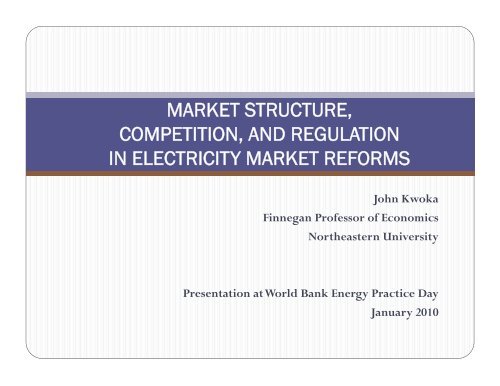market structure, competition, and regulation in electricity market ...
market structure, competition, and regulation in electricity market ...
market structure, competition, and regulation in electricity market ...
You also want an ePaper? Increase the reach of your titles
YUMPU automatically turns print PDFs into web optimized ePapers that Google loves.
MARKET STRUCTURE,<br />
COMPETITION, AND REGULATION<br />
IN ELECTRICITY MARKET REFORMS<br />
John Kwoka<br />
F<strong>in</strong>negan Professor of Economics<br />
Northeastern University<br />
Presentation at World Bank Energy Practice Day<br />
January 2010
ELECTRICITY RESTRUCTURING<br />
• Electric sector has been last to undergo restructur<strong>in</strong>g <strong>and</strong><br />
regulatory reform<br />
• Despite policy preference for simple structural solutions, not possible<br />
<strong>in</strong> <strong>electricity</strong><br />
• Reason is that <strong>electricity</strong> reforms more complex, difficult than other<br />
sectors<br />
• Numerous dist<strong>in</strong>ctive challenges<br />
• Distribution <strong>and</strong> transmission largely rema<strong>in</strong> natural monopolies<br />
• Difficulties <strong>in</strong> preserv<strong>in</strong>g strong <strong>competition</strong> <strong>in</strong> generation<br />
• Search for alternatives to vertical <strong>in</strong>tegration for coord<strong>in</strong>ation<br />
• Ambiguous role for <strong>competition</strong> <strong>in</strong> retail supply
EXPERIENCE WITH REFORMS<br />
• Most developed countries have encountered difficulties <strong>in</strong> restructur<strong>in</strong>g<br />
• UK was early, but problems with <strong>market</strong> power, pric<strong>in</strong>g, <strong>in</strong>vestment<br />
coord<strong>in</strong>ation<br />
• now <strong>in</strong> 3 rd generation of reforms<br />
• US has patchwork of different <strong>and</strong> chang<strong>in</strong>g federal <strong>and</strong> state reforms<br />
• record <strong>in</strong>cludes some significant successes, but also major failures<br />
• reforms now stalled<br />
• EU has had several successive <strong>electricity</strong> directives<br />
• attempted to open up national <strong>market</strong>s, create <strong>in</strong>dependent system operators,<br />
<strong>and</strong> develop retail <strong>competition</strong><br />
• uneven progress among EU countries<br />
• Develop<strong>in</strong>g countries face additional issues:<br />
• Public ownership, th<strong>in</strong> <strong>market</strong>s, barriers to entry, <strong>in</strong>stitutional weaknesses,<br />
development objectives<br />
• Experience even more varied
DISCUSSION TODAY<br />
• Focus on difficulties faced by developed countries <strong>in</strong><br />
restructur<strong>in</strong>g<br />
• Those difficulties, plus more, faced by develop<strong>in</strong>g countries<br />
• Specific questions:<br />
• How far can pure structural reforms go toward achiev<strong>in</strong>g<br />
lb liberalized l <strong>electricity</strong> <strong>market</strong>s?<br />
• If more than structural reform is necessary, what is that<br />
“more”?
STRUCTURAL REFORMS<br />
• Multiple dimensions of structural reform<br />
• Vertical separation of generation from transmissiondistribution<br />
• Horizontal fragmentation of generation<br />
• Vertical separation of distribution from supply<br />
• Ultimate purpose was/is to facilitate <strong>competition</strong> <strong>in</strong><br />
generation<br />
• Also to ensure equal access to transmission grid<br />
• And to allow <strong>regulation</strong> better suited to residual parts of<br />
bus<strong>in</strong>ess
VERTICAL DEINTEGRATION<br />
• Difficult to envision how generation <strong>competition</strong> can occur without<br />
vertical de<strong>in</strong>tegration<br />
• Possible to have merchant generation arise<br />
• But rout<strong>in</strong>ely denied access to transmission grid by <strong>in</strong>tegrated utilities<br />
• For this reason UK <strong>and</strong> most counties have m<strong>and</strong>ated divestiture of<br />
generation<br />
• US experience different<br />
• Tried equal access rules, but those failed <strong>in</strong> face of <strong>in</strong>tegrated utilities with<br />
operat<strong>in</strong>g control of grid, ownership of grid, <strong>in</strong>centives to deny access<br />
• Next tried to modify control but not ownership by creat<strong>in</strong>g Regional<br />
Transmission Organizations to operate grid assets that were still owned by<br />
utilities<br />
• Six RTOs now exist but problems have emerged with respect to costs,<br />
governance, <strong>and</strong> effectiveness<br />
• Some <strong>in</strong>terest <strong>in</strong> transcos, which would own <strong>and</strong> operate grid <strong>in</strong> region
VERTICAL INTEGRATION<br />
• If full vertical de<strong>in</strong>tegration necessary, clear there are some<br />
costs<br />
• Integration confers real economies between generation <strong>and</strong><br />
downstream stages<br />
• Information/risk<br />
i • Transaction cost<br />
• Coord<strong>in</strong>ation<br />
• To this extent, any benefits from generation <strong>competition</strong> ii<br />
must be weighed aga<strong>in</strong>st<br />
• possible loss of vertical economies<br />
• Plus, any efficiency consequences (positive or negative) for<br />
divested distribution sector
THE EVIDENCE<br />
• Some evidence <strong>in</strong> US <strong>and</strong> elsewhere that divested generation operat<strong>in</strong>g<br />
more efficiently<br />
• Fabrizio et al (2007) f<strong>in</strong>d 5% decl<strong>in</strong>e <strong>in</strong> labor <strong>and</strong> nonfuel expenses<br />
• Bushnell <strong>and</strong> Wolfram (2005) report 2% reduction <strong>in</strong> fuel usage<br />
• Newbury <strong>and</strong> Pollitt (2001997) f<strong>in</strong>d 5% cost sav<strong>in</strong>gs from UK reforms of<br />
generation, transmission stages<br />
• Good evidence <strong>in</strong> US, elsewhere of vertical economies between<br />
generation <strong>and</strong> transmission <strong>and</strong>/or distribution<br />
• Michaels (2006) reports 11 of 12 studies f<strong>in</strong>d such vertical economies<br />
• Kwoka study (2002) has typical overall f<strong>in</strong>d<strong>in</strong>g of substantial economies<br />
• Net effect is size-related: Tradeoff between extra fixed costs attributable to<br />
each function, vs. variable cost complementarities<br />
i<br />
• Implies efficient operation by sufficiently small de<strong>in</strong>tegrated utilities<br />
• Sources of economies largely <strong>in</strong> operations costs of both transmission <strong>and</strong><br />
distribution, plus some sav<strong>in</strong>gs overhead/ adm<strong>in</strong>istration
THE EVIDENCE, CONTINUED<br />
• Some evidence <strong>in</strong> US that divested distribution utilities performed<br />
less efficiently<br />
• One study f<strong>in</strong>ds divestitures required by state PUCs result <strong>in</strong><br />
significant efficiency losses by result<strong>in</strong>g distribution companies<br />
• Potentially another cost to be weighed aga<strong>in</strong>st benefits of<br />
de<strong>in</strong>tegration<br />
• Numerous studies of overall effects of restructur<strong>in</strong>g <strong>in</strong> US, but<br />
many are flawed<br />
• Kwoka review (2006) of 12 studies f<strong>in</strong>ds “no reliable <strong>and</strong> conv<strong>in</strong>c<strong>in</strong>g<br />
evidence that consumers are better off as a result of restructur<strong>in</strong>g”<br />
• Hence, to extent there are benefits, they range widely <strong>in</strong><br />
magnitude <strong>and</strong> certa<strong>in</strong>ty<br />
• Studies highlight areas where reforms need careful attention
DETERMINANTS OF BENEFITS<br />
• Benefits of restructur<strong>in</strong>g are likely a function of the but-for world <strong>and</strong> the<br />
nature of reforms<br />
• The but-for world differs from country to country<br />
• Depends on ownership, <strong>regulation</strong>, technology, history, <strong>in</strong>stitutions,<br />
<strong>in</strong>centives<br />
• For example, US had largely l private utilities, with relatively l effective <strong>and</strong><br />
efficient <strong>regulation</strong><br />
• Regulation restra<strong>in</strong>ed <strong>market</strong> power, limited transfers from consumers to<br />
producers, ensured supply ppy<strong>and</strong> quality<br />
• But little <strong>in</strong>novation, <strong>in</strong>efficient distribution of risk, distorted <strong>in</strong>fra<strong>structure</strong><br />
• Still, this is case where efficiency ga<strong>in</strong>s <strong>in</strong> generation likely to be modest, at<br />
least <strong>in</strong> short to medium run<br />
• By contrast, UK had <strong>in</strong>efficient publicly owned utilities, with high energy<br />
cost production<br />
• Potential benefits more straightforward, though still some debate as to<br />
exact magnitude
DETERMINANTS, CONTINUED<br />
• Several necessary elements for successful reform:<br />
• First, ownership unbundl<strong>in</strong>g/de<strong>in</strong>tegration, g rather than partial<br />
unbundl<strong>in</strong>g<br />
• US, other countries have tried account<strong>in</strong>g unbundl<strong>in</strong>g, functional<br />
unbundl<strong>in</strong>g, legal unbundl<strong>in</strong>g<br />
• Ownership unbundl<strong>in</strong>g creates thicker <strong>market</strong>s (assum<strong>in</strong>g necessary<br />
size of <strong>market</strong>), avoids distorted <strong>in</strong>centives<br />
• Alternatives leave distorted <strong>in</strong>centives need for regulatory<br />
• Alternatives leave distorted <strong>in</strong>centives, need for regulatory<br />
<strong>in</strong>tervention<br />
• Unlikely to create equal access<br />
• Hence will fail to br<strong>in</strong>g about <strong>competition</strong> <strong>in</strong> generation
• Second, competitive supply side <strong>in</strong> generation<br />
• If <strong>competition</strong> <strong>in</strong> generation is central purpose of reforms,<br />
crucial that it be structurally <strong>and</strong> behaviorally competitive<br />
• Several aspects to this:<br />
• Initial conditions <strong>in</strong>volv<strong>in</strong>g numerous generators/bidders<br />
• Reduce/elim<strong>in</strong>ate barriers to new entry from sit<strong>in</strong>g, etc.<br />
• Control of mergers<br />
• Prevent collusive <strong>and</strong> anticompetitive titi behavior<br />
• Requires careful restructur<strong>in</strong>g policy at outset, plus<br />
• Attentive <strong>and</strong> capable <strong>competition</strong> policy<br />
• Independent <strong>and</strong> capable <strong>market</strong> monitors
• Third, well designed auction <strong>market</strong>s<br />
• Design df defensively–that is, avoid rules subject to <strong>market</strong><br />
manipulation<br />
• Experience of California, others<br />
• Create oversights <strong>and</strong> checks for anticompetitive behavior<br />
• Strategic t withhold<strong>in</strong>g<br />
• Limit cross-ownership/contract<strong>in</strong>g among bidder<br />
• Needed to prevent common knowledge of all generators’ costs, etc.<br />
• Data disclosure <strong>and</strong> transparency<br />
• Most US RTOs do not disclose much <strong>in</strong>formation
• Four, efficient <strong>and</strong> effective transmission organizations<br />
• Needed d <strong>in</strong> order to perform functions previously done by <strong>in</strong>tegrated<br />
utilities<br />
• Coord<strong>in</strong>at<strong>in</strong>g dispatch<br />
• Investment plann<strong>in</strong>g<br />
• Congestion relief (which can be serious threat to reform)<br />
• Very important s<strong>in</strong>ce one study shows alternative <strong>in</strong>stitutions<br />
(like power pools, ISOs) can recover much of cost penalty from<br />
de<strong>in</strong>tegration<br />
• Best practice appears to be publicly owned <strong>and</strong> regulated<br />
p pp p y g<br />
transmission operator<br />
• Current alternatives <strong>in</strong> US–RTOs–have not performed well
• Five, resolv<strong>in</strong>g the role for retail <strong>competition</strong><br />
• Clear that supply can be separated from wires/distribution<br />
• Little empirical evidence concern<strong>in</strong>g effects or benefits<br />
• But if done, needs careful design (not like US)<br />
• Other aspect to retail is possibility of <strong>in</strong>tegrat<strong>in</strong>g g supply ppy with<br />
generation<br />
• Both are potentially competitive segments<br />
• Have potential economies that could be captured by jo<strong>in</strong>t<br />
ownership<br />
• <strong>in</strong>ternalize some <strong>in</strong>formation<br />
• h<strong>and</strong>le risk of st<strong>and</strong>alone generation<br />
• ensure supply<br />
• provide for <strong>in</strong>vestment
• Six, residual <strong>regulation</strong> of monopoly segments<br />
• Incentive <strong>regulation</strong> has high powered <strong>in</strong>centives for cost control<br />
• But design features are crucial to magnitude <strong>and</strong> distribution of benefits<br />
• Seems clear that <strong>in</strong>centive <strong>regulation</strong> may not protect service<br />
quality<br />
• Nor provide adequate <strong>in</strong>centives for <strong>in</strong>vestment<br />
• Studies of quality <strong>and</strong> <strong>in</strong>vestment t underscore concerns<br />
• These issues require careful attention to prevent un<strong>in</strong>tended<br />
These issues require careful attention to prevent un<strong>in</strong>tended<br />
effects
LESSON FROM PAST EXPERIENCE<br />
• One simple lesson from experience, buttressed by studies:<br />
• Restructur<strong>in</strong>g may be necessary, but it is not sufficient<br />
• Must be part of a reform package<br />
• Undertak<strong>in</strong>g any s<strong>in</strong>gle piece–certa<strong>in</strong>ly alter<strong>in</strong>g <strong>market</strong> <strong>structure</strong>–will<br />
not work<br />
• May even be counterproductive ti by itself<br />
• Traditional <strong>structure</strong>s may be “local maximum”<br />
• Global maximum requires complementary reforms,<br />
supplementary <strong>in</strong>stitutions<br />
• Must also be attentive to <strong>in</strong>itial conditions <strong>and</strong> capabilities of each<br />
country <strong>and</strong> jurisdiction<br />
• Even with all that, must be prepared to make real-time adjustments<br />
<strong>and</strong> corrections





